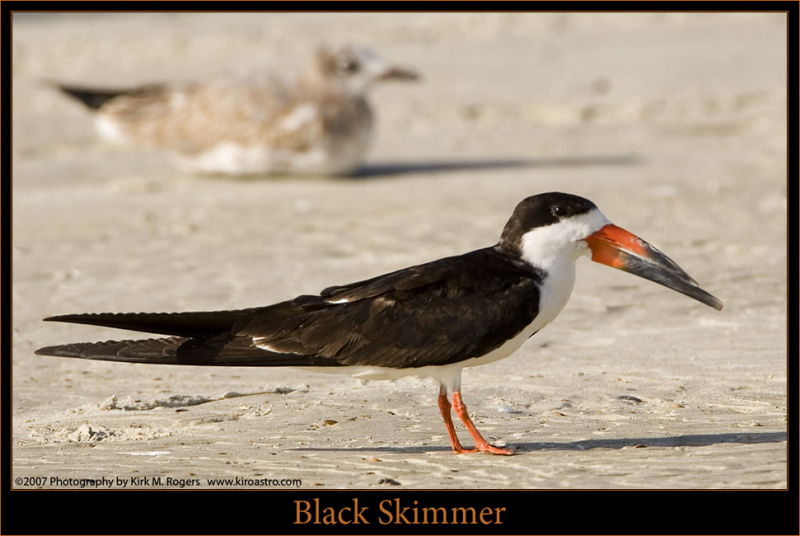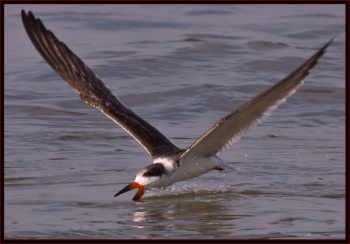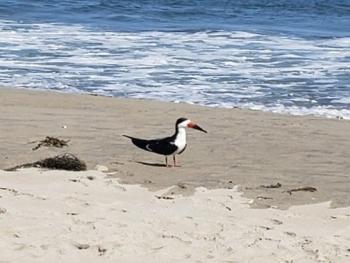Dorian may have glanced by us more than a week ago, but some unusual birds it impacted are just now appearing here in Maine. The two of us had a chance to spend a little time scanning birds along the shores of southern Maine in the week that followed the hurricane. We didn’t find anything outrageous but we did notice a fair number of laughing gulls and a Forster’s tern that we thought might have been blown back north. We also noticed a number of lesser black-backed gulls and wondered if they could have actually been blown south earlier than normal because of the counter-clockwise rotation of the hurricane winds at it passed east of Newfoundland and Greenland. You may remember that we have written in the past about the likely Greenland origins of the lesser black-backed gulls we see here in Maine.
As is sometimes our luck, the day after we scanned the shores unsuccessfully for major hurricane oddities, birders in Scarborough discovered some. The species they found was the black skimmer—a bird that has only shown up here in Maine after hurricanes. About the size of a small gull and with black upperparts and white underparts, the black skimmer is defined by its crazy-looking bill, which is a huge, bright reddish-orange affair with a black tip. The top half of the bill is closer to a “normal” bird bill in shape. But the lower mandible is like something from a drawing of an imaginary creature—a narrow knife-edged blade jutting out well beyond the tip of the upper mandible.
To feed, the skimmer glides just inches above the surface of the water and lowers its knife-like lower mandible into the water, cutting into the upper surface. When it makes contact with an unsuspecting small fish, it snaps the knife edge up and captures the fish in a pincer grip. Often it feeds at night, perhaps so that fish can’t easily spot their silhouettes against the dark sky.
More black skimmers have appeared here in Maine as birds carried by Hurricane Dorian to the Maritimes begin struggling to find food and make their way back south to warmer climes. In fact, one of the Boothbay Register staff discovered and tweeted a photo of a black skimmer this week from Popham Beach.
With luck, we ourselves may find some time to go looking for one of these amazing birds while they are still in the state.
Birders here in Maine might find some other hurricane-blown oddities headed south as species like gull-billed terns and royal terns are still being found in Nova Scotia and New Brunswick.
In the category of “Maine avian oddities not likely related to Hurricane Dorian,” a swallow-tailed kite (one of our favorite birds to see in spring in Florida) was found this past weekend Downeast in Dennysville. A number of American avocets also appeared, including two that had spent considerable time at Scarborough Marsh even before the hurricane.
Soon we’ll be giving an update about our “Mindfulness Maine Birding Big Year.” By then, will these species have been added to our list? We hope so!
Jeffrey V. Wells, Ph.D., is a Fellow of the Cornell Lab of Ornithology and Vice President of Boreal Conservation for National Audubon. Dr. Wells is one of the nation's leading bird experts and conservation biologists and author of “Birder’s Conservation Handbook”. His grandfather, the late John Chase, was a columnist for the Boothbay Register for many years. Allison Childs Wells, formerly of the Cornell Lab of Ornithology, is a senior director at the Natural Resources Council of Maine, a nonprofit membership organization working statewide to protect the nature of Maine. Both are widely published natural history writers and are the authors of the book, “Maine’s Favorite Birds” and “Birds of Aruba, Bonaire, and Curaçao: A Site and Field Guide” from Cornell Press.

































